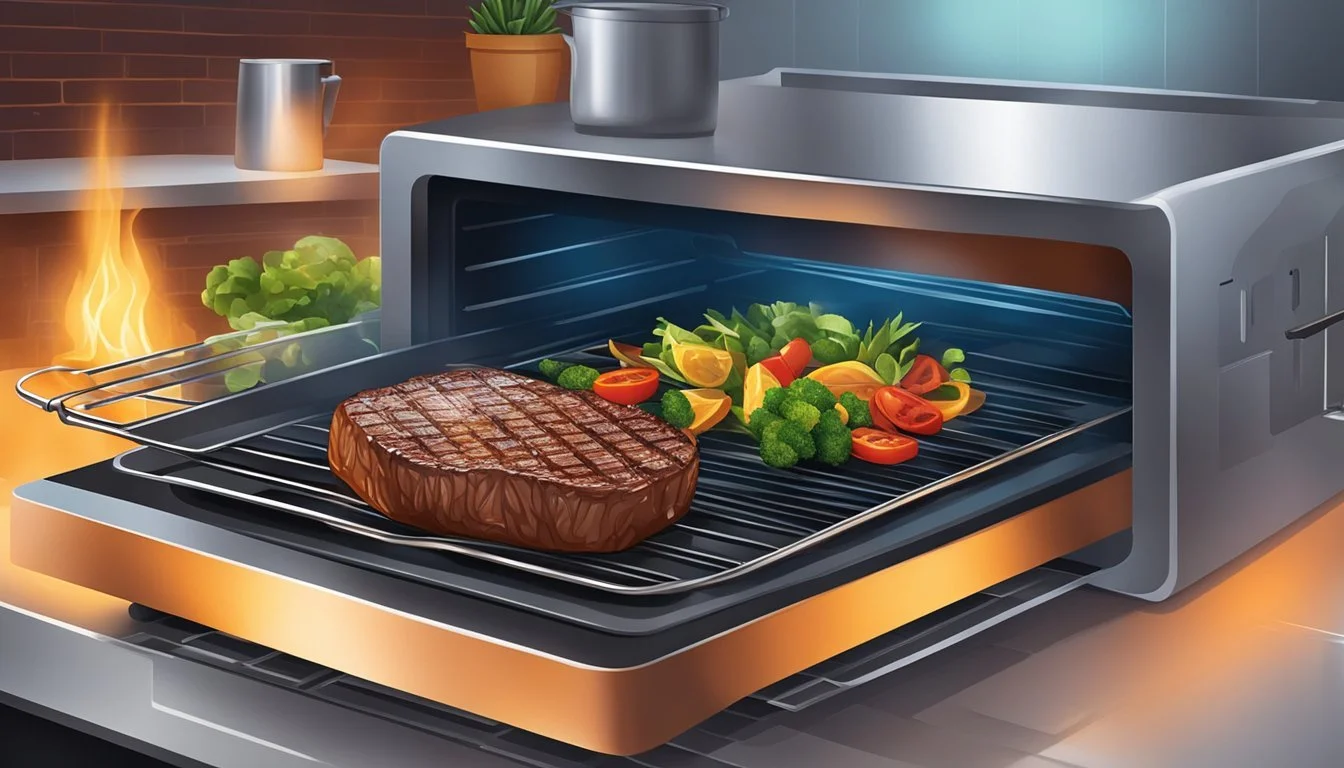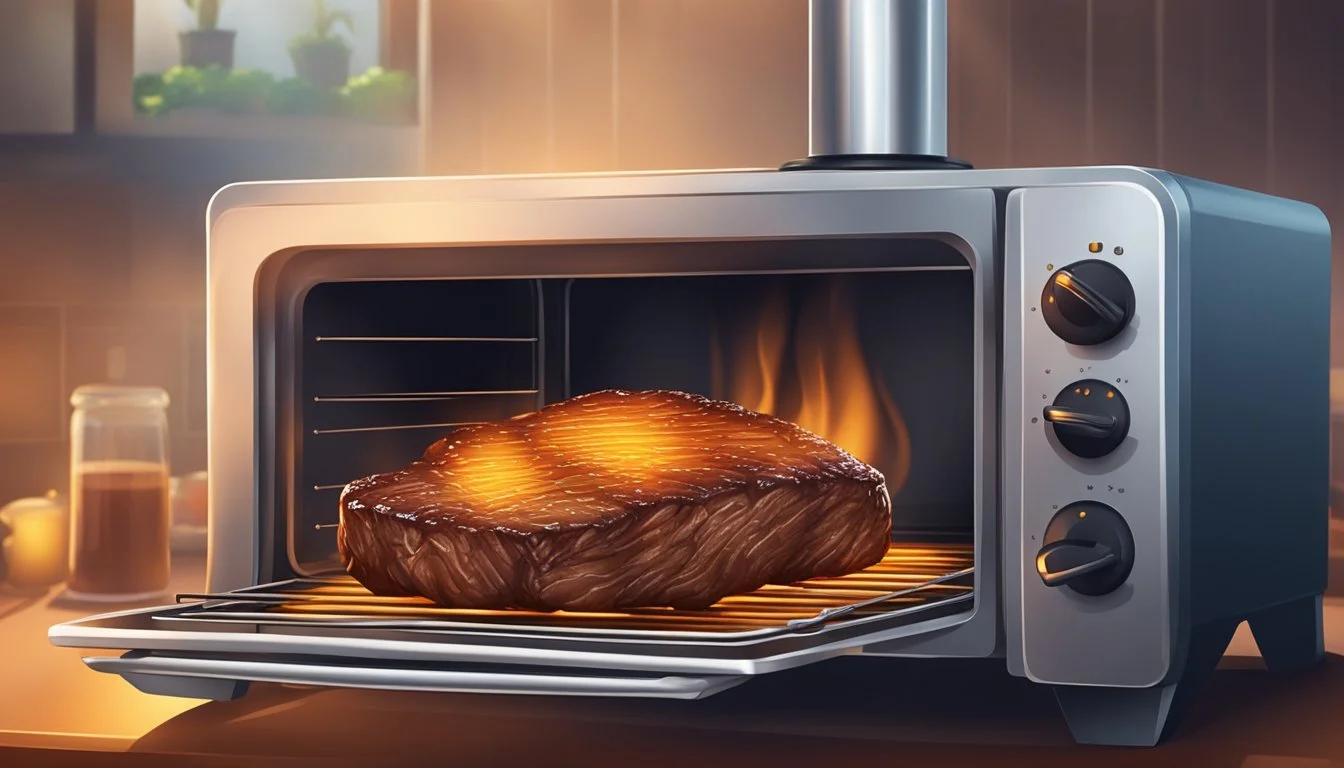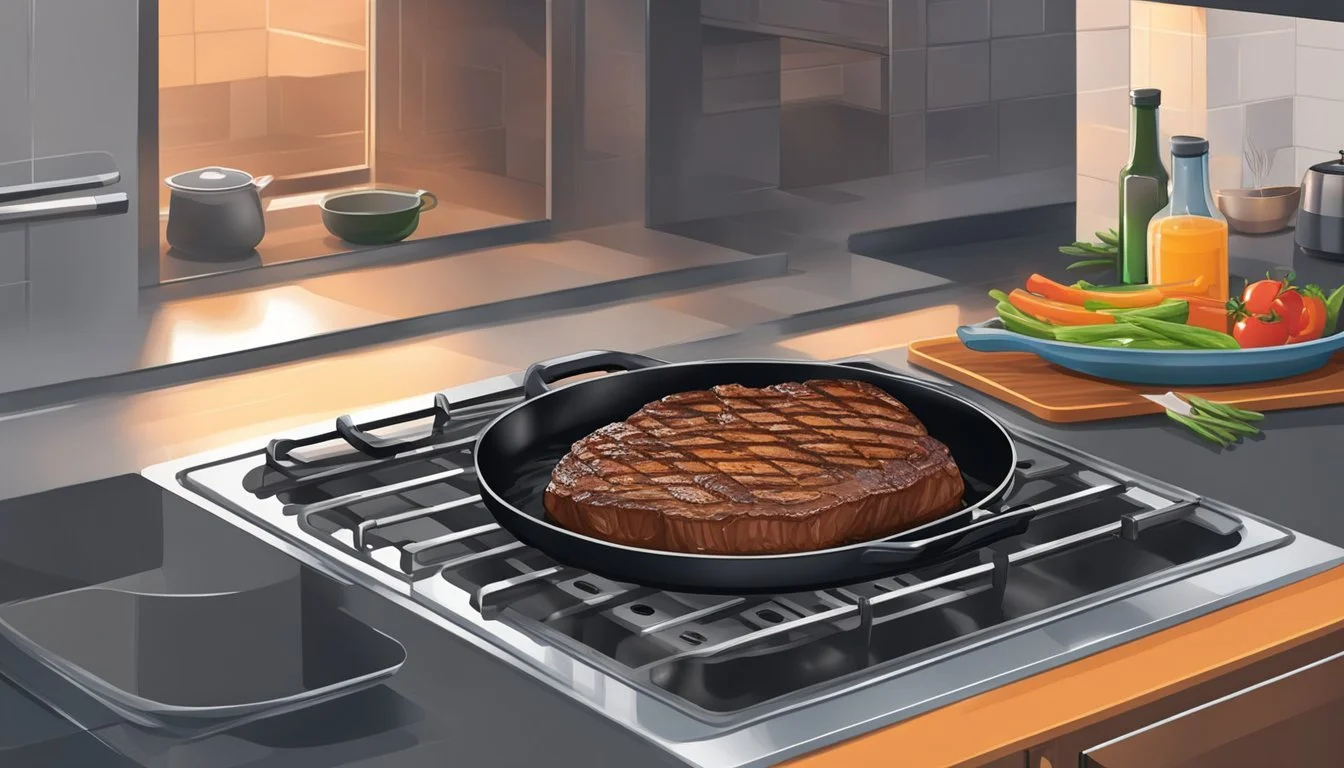How to Cook a Steak in the Oven
Perfect Restaurant-Quality Results
Cooking a perfect steak doesn't always require a grill or stovetop. The oven offers a reliable method to achieve a juicy, flavorful steak with minimal fuss. To cook steak in the oven, preheat to 450°F (232°C), season the meat generously, and sear it in a hot oven-safe skillet before finishing in the oven until it reaches your desired doneness.
This technique combines the best of both worlds - a crispy, caramelized exterior from the initial sear and an evenly cooked interior from the oven's consistent heat. It's an ideal approach for those who don't have access to outdoor grilling space or prefer a more controlled cooking environment.
Oven-cooked steaks can turn out just as delicious as their grilled counterparts when done correctly. The key lies in choosing the right cut of meat, proper seasoning, and understanding the balance between cooking time and temperature. With a few simple steps, anyone can master the art of cooking steak in the oven and enjoy restaurant-quality results at home.
Preparing the Steak
Proper preparation is crucial for achieving a perfectly cooked steak in the oven. The right cut, temperature, seasoning, and oven setup all play important roles in the final result.
Selecting the Right Cut
Choose cuts with good marbling for the best flavor and tenderness. Ribeye, filet mignon, and New York strip are excellent options for oven cooking. T-bone and porterhouse steaks also work well, offering a combination of tenderloin and strip.
Sirloin can be a more budget-friendly choice while still providing good results. For thinner cuts, consider flank steak, skirt steak, or hanger steak.
Aim for steaks that are at least 1-inch thick. This helps prevent overcooking and allows for a nice crust while maintaining a juicy interior.
Bringing Steak to Room Temperature
Remove the steak from the refrigerator 30-60 minutes before cooking. This allows it to reach room temperature, promoting even cooking throughout.
Pat the steak dry with paper towels to remove excess moisture. This step is crucial for achieving a good sear and crust.
Allowing the steak to warm up slightly also helps it cook more evenly, reducing the risk of an overcooked exterior and undercooked center.
Seasoning Your Steak
Keep seasoning simple to let the steak's natural flavors shine. Kosher salt and freshly ground black pepper are classic choices.
Season generously on all sides. The salt will help form a flavorful crust.
For added flavor, consider rubbing the steak with olive oil and minced garlic. Fresh herbs like rosemary or thyme can also enhance the taste.
Allow the seasoned steak to rest for about 15 minutes. This gives the salt time to penetrate the meat.
Preheat Your Oven
Set your oven to 400°F (200°C) for medium-thick steaks. For thicker cuts, you may want to lower the temperature to 375°F (190°C).
If using a cast-iron skillet, place it in the oven while it preheats. This ensures the pan is hot enough to create a good sear.
For the reverse sear method, preheat to a lower temperature of 275°F (135°C).
Check that your oven rack is positioned in the middle. This allows for even heat distribution around the steak.
Cooking Methods
Several techniques can be used to cook steak in the oven, each producing different results in terms of texture and flavor. The choice of method depends on personal preference and the cut of steak.
Oven Searing Technique
Start by preheating the oven to 450°F (232°C). Pat the steak dry with paper towels and season generously with salt and pepper. Heat a cast-iron skillet over high heat on the stovetop until very hot.
Add a small amount of oil to the skillet and sear the steak for 30 seconds on each side to develop a flavorful crust. Transfer the skillet with the steak to the preheated oven.
Cook for 2-3 minutes per side for medium-rare, or adjust the time based on desired doneness. Use a meat thermometer to check the internal temperature:
Rare: 125°F (52°C)
Medium-rare: 135°F (57°C)
Medium: 145°F (63°C)
Well-done: 160°F (71°C)
Let the steak rest for 5-10 minutes before serving to allow juices to redistribute.
Reverse Searing Technique
Preheat the oven to 275°F (135°C). Place the seasoned steak on a wire rack set over a baking sheet. Cook the steak in the oven until it reaches an internal temperature about 10-15°F below your desired final temperature.
Remove the steak from the oven and let it rest while heating a cast-iron skillet over high heat. Sear the steak for 30-60 seconds per side to develop a crisp crust.
This method allows for more even cooking throughout the steak and better control over the final temperature. It's particularly effective for thicker cuts of steak.
Broiling Option
Set the oven to broil and place the oven rack about 4-6 inches from the heating element. Preheat a cast-iron skillet or oven-safe pan under the broiler for 5 minutes.
Season the steak and place it in the hot skillet. Broil for 3-4 minutes on each side for medium-rare, adjusting the time based on thickness and desired doneness.
Use a meat thermometer to check the internal temperature. Allow the steak to rest for 5 minutes before serving.
Broiling provides intense heat from above, creating a nicely browned exterior while keeping the interior juicy. It's a quick method that works well for thinner steaks.
Cooking Times and Temperatures
Achieving the perfect steak in the oven requires precise timing and temperature control. The key factors are steak thickness, desired doneness, and proper use of a meat thermometer.
Using a Meat Thermometer
A meat thermometer is essential for cooking steak to your desired doneness. Insert it into the thickest part of the steak, avoiding fat or bone. For accurate readings, push it in at least 1/2 inch.
Digital instant-read thermometers provide quick results. Leave-in thermometers can stay in the steak while cooking, allowing continuous monitoring.
Remember to clean the thermometer after each use to prevent cross-contamination.
Temperature Guide for Steak Doneness
Different levels of doneness correspond to specific internal temperatures:
Rare: 125°F (52°C)
Medium-rare: 135°F (57°C)
Medium: 145°F (63°C)
Medium-well: 150°F (66°C)
Well-done: 160°F (71°C)
Remove the steak from the oven when it's 5°F below your target temperature. The internal temperature will continue to rise during resting.
Cooking times vary based on steak thickness. A 1-inch thick steak typically takes 10-12 minutes for medium-rare at 400°F (204°C).
For a juicy steak, allow it to rest for 5-10 minutes after cooking. This helps redistribute the juices throughout the meat.
Finishing Touches and Resting
The final steps of cooking a steak in the oven are crucial for enhancing flavor and ensuring optimal texture. Proper seasoning, resting, and the addition of compound butter can elevate your steak to restaurant-quality levels.
Applying Additional Seasonings
After removing the steak from the oven, consider adding a final layer of seasoning to enhance its flavor profile. Sprinkle sea salt and freshly ground black pepper over the caramelized crust.
For a more complex taste, lightly dust the steak with garlic powder or finely chopped fresh herbs like rosemary and thyme. These aromatics will infuse the meat with additional depth as it rests.
Be cautious not to overseason, as the steak should have already been salted before cooking. A light touch is key to complementing rather than overpowering the natural flavors of the meat.
Letting the Steak Rest
Resting is a critical step that allows the juices to redistribute throughout the meat, resulting in a more tender and flavorful steak. Place the cooked steak on a cutting board or warm plate.
• Rest time: 5-10 minutes for thin cuts, 10-15 minutes for thicker steaks • Cover loosely with foil to retain warmth • Avoid cutting into the steak during this time
During the resting period, the internal temperature will continue to rise slightly, completing the cooking process. This step ensures a juicy steak with optimal texture and flavor distribution.
Making Compound Butter
Compound butter is a luxurious addition that can take a steak from good to exceptional. To prepare:
Soften unsalted butter at room temperature
Mix in finely chopped herbs (e.g., parsley, chives)
Add minced garlic or shallots if desired
Season with salt and pepper to taste
Shape the butter into a log using plastic wrap and chill until firm. Just before serving, place a slice of the compound butter on top of the hot steak. The heat will melt the butter, creating a rich, flavorful sauce that coats each bite.
Serving and Presentation
Proper serving and presentation elevate a perfectly cooked steak to a restaurant-quality experience. Attention to slicing, accompaniments, and plating techniques can transform a simple meal into a memorable dining event.
Slicing the Steak
Allow the steak to rest for 5-10 minutes after cooking. This lets the juices redistribute throughout the meat. Use a sharp knife to slice against the grain. Cutting against the grain shortens the muscle fibers, resulting in a more tender bite.
Place the steak on a cutting board and hold it steady with tongs. Slice at a slight angle, creating pieces about 1/4 to 1/2 inch thick. For larger steaks, consider pre-slicing before serving to make sharing easier.
Accompaniments and Sides
Pair the steak with complementary sides to create a balanced meal. A crisp green salad adds freshness and lightness to contrast the rich meat. Roasted vegetables like asparagus or Brussels sprouts offer texture and nutritional value.
For a classic steakhouse experience, serve with a baked potato topped with sour cream and chives. Creamy mashed potatoes or garlic bread are also popular choices. Consider offering a red wine reduction sauce or compound butter to enhance the steak's flavor.
Plating Techniques
Arrange the sliced steak on a warmed plate to maintain its temperature. Use an odd number of slices for visual appeal. Position the meat slightly off-center, allowing space for sides.
Fan out the slices in a curved line or stack them in a neat pile. Place accompaniments strategically around the steak, considering color contrast and balance. Garnish with fresh herbs like parsley or thyme for a pop of color.
For a rustic presentation, serve the steak on a wooden board with sides in small bowls. This family-style approach encourages sharing and creates a relaxed atmosphere.
Alternative Cooking Options
While oven-roasting produces excellent results, other methods can yield delicious steaks. Stovetop cooking offers precise control, while grilling imparts a smoky flavor.
Stovetop Preparation
Cooking steak on the stovetop provides quick and flavorful results. A heavy-bottomed pan, preferably cast iron, is ideal for this method. Heat the pan over medium-high heat until very hot. Pat the steak dry with a paper towel and season generously.
Add a small amount of oil to the pan and carefully place the steak in it. Sear for 3-4 minutes on each side for medium-rare, adjusting time based on thickness and desired doneness.
For a caramelized crust, avoid moving the steak too frequently. Use tongs to flip and check for doneness. Let the steak rest for 5-10 minutes before serving to allow juices to redistribute.
Outdoor Grilling
Grilling imparts a distinctive smoky flavor to steaks. Preheat the grill to high heat. Clean and oil the grates to prevent sticking. Pat the steak dry and season well.
Place the steak on the hot grill and cook for 4-5 minutes per side for medium-rare, depending on thickness. Use tongs to flip the steak only once if possible.
For perfect grill marks, rotate the steak 45 degrees halfway through cooking on each side. Remove the steak when it reaches desired doneness and let it rest for 5-10 minutes before slicing.
To check doneness, use a meat thermometer or the touch test. A rare steak feels soft, medium-rare is slightly firmer, and well-done feels very firm.
Cleaning and Maintenance
Proper care of your cookware ensures optimal performance and longevity when cooking steaks in the oven. Regular cleaning and maintenance are essential for both cast iron and oven-safe skillets.
Cleaning Your Cookware
Clean your skillet immediately after use. For cast iron, use hot water and a stiff brush to remove food particles. Avoid soap, as it can strip the seasoning. For stubborn bits, scrub with coarse salt. Dry thoroughly with a clean cloth or paper towel.
Oven-safe stainless steel skillets can be washed with mild soap and warm water. Use a non-abrasive sponge to prevent scratching. For tough residue, soak in hot water before cleaning.
Never put hot skillets in cold water, as this can cause warping. Allow them to cool naturally before cleaning.
Skillet Seasoning and Care
Cast iron skillets require regular seasoning to maintain their non-stick surface. After cleaning, apply a thin layer of cooking oil using a pastry brush or paper towel. Heat the skillet in a 350°F oven for an hour, then let it cool.
Store cast iron in a dry place to prevent rust. If rust appears, scrub it off with steel wool and re-season the skillet.
For other oven-safe skillets, avoid using metal utensils that can scratch the surface. Instead, opt for wooden or silicone spatulas. Store them in a dry area to prevent moisture damage.
Regular maintenance will keep your cookware in top condition for perfectly pan-seared steaks.




